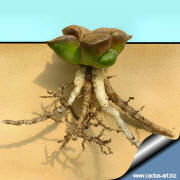|

(Photo 1)
Haworthia emelyae v. comptoniana.
The
tuberose roots of this
succulent geophyte
are
Contractile and pull the plant deeper into the
soil to protect the
perennating
bud from
sun and
heat
during the
dry
season.
|
Geophytes are a kind of
plant having the capability to
survive arid
environmental conditions
by dying back to
underground
storage organs.
Storage organs are reserves
of food (e.g.
carbohydrates,
proteins),
nutrients (e.g.
mineral salt), and
water, and may be classified
as bulbs,
corms,
rhizomes,
stem tubers,
root tubers, and enlarged
hypocotyls (caudex).
This phase in geophyte
development is often
referred to as a dormancy
period or resting
stage; however, such terms are misleading. The
storage organ is
never physiologically
dormant even when
aerial growth is halted. It
continues to change and constantly senses its
environment so the term
"dormancy" will
more properly refers to the period of the geophyte
life cycle when there is
no above-ground
tissue.
The above ground
portions of the plant
(usually annual
deciduous
shoots or
leaves) typically die off
during the dry parts of the
year or in the
winter season leaving only
the storage organs in
the soil, but the plant is
able to "re"-sprout
when the environmental
conditions are appropriate using the
food
reserves in the
underground portion and as a
result, geophytes in their
natural
habitats are capable of
perennial
life cycles.
Most geophytic plant species
may be propagated by division
or proliferation of
the
underground structure such as a bulbs,
rhizomes,
tubers,.
|